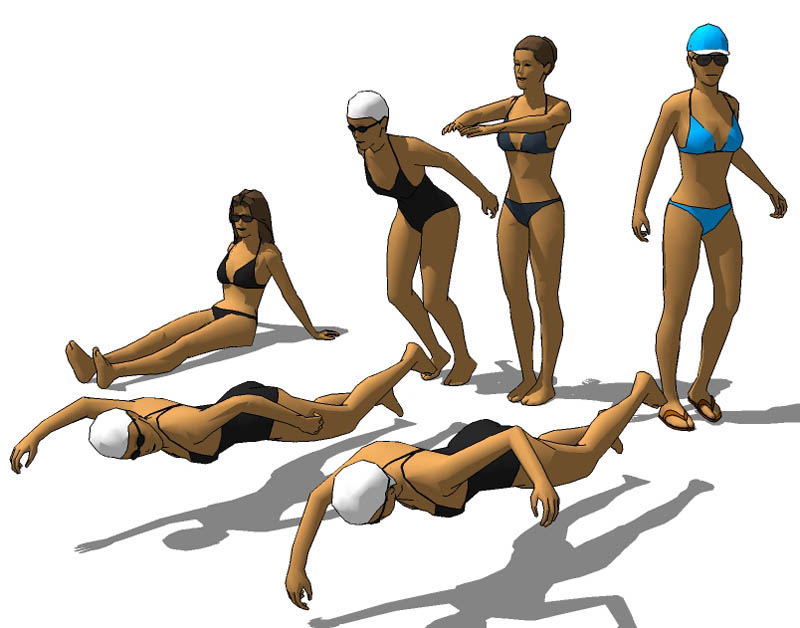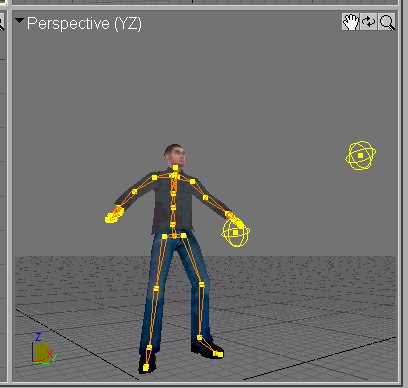Rigging ruby [req]
-
Ruby masters, I need your advice and help yet again.
I am currently putting together a workflow for upcoming tutorials and would like to know if a ruby can be made to help my and everyone's workflow in regards to rigging characters, trees, pretty much anything that can be rigged.
Rigging is pretty straight forward when the parts needing posing are components that do not share a mesh, however once they do then rigging becomes impossible. Below is an example of a basic quick rigging of one of my basic human models, it has been grouped at strategic points so that when exploded I can use the rotate tool to do the rigging, and as soon as the possition is obtained the mesh is regrouped.
I was wondering if the was a way of moving and rotating the group without exploding it and the mesh could still stay 'sticky' to the joining mesh? or if y'all can devise a better way of rigging that will blow me away.
[flash=600,350:2v68dcrt]http://vimeo.com/moogaloop.swf?clip_id=2923376&server=vimeo.com&show_title=1&show_byline=1&show_portrait=0&color=00ADEF&fullscreen=1[/flash:2v68dcrt]
-
+1 For Rigging
it could be so useful and time saving to have an option key with "suspend groups" in SU.
So you can edit groups without having to double click on them or explode them. -
That would indeed be a simple way to implement a form of rigging, Pete.
It would be totally cool if it would be an extended rigging system, where you first 'bone' your characters (we already have a 'joint' ruby don't we?), and then 'rig' them.
It would involve automatically subdividing the areas of the skin close to the joints though.....I guess Sketchup would be brought to its knees again, polycount wise that is...(mown)...(yawn)...
-
aaargh!
why will you give to sketchup the functionality of Poser2?
 Can you see all the Poser nerds migrating to Sketchup to populate google earth with tons of NVWSIFOAS (naked viki with swords in fron of a shrine)?
Can you see all the Poser nerds migrating to Sketchup to populate google earth with tons of NVWSIFOAS (naked viki with swords in fron of a shrine)? 
-
That's not a valid argument Matteo.
It would be the same to say : 'Don't have an architectural modeler because of all the bad doodle houses the 3D warehouse is cluttered with.'Solo suggested a pretty easy way to get basic rigging done in sketchup. Nothing wrong with that.
I can see a lot of uses for such a ruby. As Solo suggested, making custom trees is one of them.
-
What you need is something similar in principle to the FFD, but that would allow you to set your own initial points anywhere you like instead of starting with a rectangular grid.
And it would be much better if the deformation worked in a similar way to Fredo's F-splines (curve passes through control points), instead of how the FFD currently works (deformed surface is detached from control points).
I see a lot of potential in such a script. Besides posing characters, it could also be used a lot in amorphous architecture... The FFD is nice but this would be like a super-turbo-charged version of it.
-
I've been rigging figures with FFD for quite some time. If you set an array of about a dozen or more control points along an arm, for instance, the distance between the middle two sets is about sufficient to bend an elbow reasonably convincingly up to quite a severe angle.
Shoulders are generally a different case. By and large, SU figures are so low poly that there simply aren't enough polygons to "spread the load" without losing all definition around the shoulder blades and collar bone. It's generally far easier to group the entire arm, move it to the required position, then stitch it back together onto the shoulder.
That's how this little lot was done. Some kind of rigging solution would be nice, but it would require quite a few extra rows of polygons around all the major joints to prevent the figure distorting something rotten.

-
Pete,
I just watched your video above. I am so envious of your ability to model. I would love to buy a video tutorial or come and do some training from you. Any ideas on either?
Jeff -
@kwistenbiebel said:
That's not a valid argument Matteo.
It would be the same to say : 'Don't have an architectural modeler because of all the bad doodle houses the 3D warehouse is cluttered with.'I was just kidding, Kwist. I like Solo's idea and what he is showing us.
I'also happy that a piece of software like Poser exists, expecially the old versions that can generate low poly 3d people to use and modify with sketchup.And btw, architectural modelers and cad programs (but also pencils, drawing paper and ink pens) should not exist, because of all the bad doodle houses the real world is cluttered with.

-
Ah, I see
 .
. -
I think I'll have to disagree with most of you.
I don't think rigging in SketchUp is ever going to be half as powerful as using it in an application thats been built around animation.
For stills it would be much better to import a ready posed character IMHO.
I don't see any need for having stiff, bold, undressed characters populating my scenes.
The first step to get any real use from rigging in SU would IMHO be to enhance animation controls. And that would not be an easy task just through ruby.
I have posted this idea before: http://www.sketchucation.com/forums/scf/viewtopic.php?f=180&t=8547&p=51051&hilit=pixero#p51051Lets face it, SU's weakest points lies in presentation. Animation is rudimentary at best and useless most of the time because of "the bug".
I'd much rather see some efforts in enhacing animation control and OpenGL to get animation working first and then presentation quality with OpenGL lights and shaders.
Then I might start wishing for better rigging capabilities. -
There was that sketchup game made by a Google team member a time ago, right?
It had a moving character and therefore animation...
Why didn't this lead to a better animation tool we can all use?Actually when seeing that demo movie on the 'Basecamp sessions' 8 months ago, I would have expected to see something implemented in SU 7...
-
Wasn't that animation just showing and hiding a bunch of "pre posed" components?
A bit like old fashioned cut-out animation.
Very rudimentary animation and a lot of hard work that isn't easily usable for what I understand. -
As Jan said, the game just used the hiding/unhiding layers method for animation, so not really a workable way of doing things.
-
I just want to refrase that I'm not AGAINST rigging in SU.
It's just that even if someone smart came up with a ruby for binding vertices to a skeleton rig with smooth fallof and you name it, there would be no way of using it in SU.
Therefore I belive one should start at the right end and enhance animation control first and then build more features like rigging on top of it. -
That was kind of my point. I agree with Jan. Rigging needs to be all or nothing. All would mean the ability of assigning relative weights to all the vertices in the area of the joint (for the uninitiated; that's telling each vertex how far it is allowed to distort...so a leg bends at the knee, not like a banana). Ideally, it would also involve the ability of converting a mesh to a skin, then back again, so that any texture mapping could move with the form.
Anything less than this...like having to get in there and repair geometry or remap a mesh after a change of pose...is no real advance on what can be achieved already, either directly in SU or by pulling in a figure created in Max or something like Lightray 3D (my modelling/rigging app of choice...and a mere snip at 69 Euro.) The fact that LR3D appears to be a one man operation, yet can handle sophisticated mapping, IK boning and animation, and pretty decent real-time rendering ought to cause Google to hang their heads in shame.

-
Well, without Sketchup being able to cope with a decent polycount, a complete rigging concept makes no sense right now. Also, as others said, the SU animation is too limited.
The 'simple' concept Solo is trying to get, however, could be a good temporary solution.
-
As far as rigging goes and how the junction at the joints are constructed, I wonder if some sort of a dynamic component could be created. It would draw an "optimized webbing" (triangulation) between two key edges or key vertices of the two structures at each "side" of the joint; the user could specify the complexity of the web such as high, medium, or low. After a structure is rotated about the joint, the web is drawn/redrawn over the joint.
-
I'm just rejoined the forums and came across this thread, which reminded me of a plugin idea I had a long time ago to accomplish pretty much exactly what you're doing here. Since it doesn't quite match this thread, I started a new one (with a link back to this thread):
-
The idea of having geometry sticking to groups and components crossed my mind once a long time ago, as I guess it has to many other people as well. I wonder what possibilities it would create for sketchy-physics if it worked

... Or maybe someone could make a script that creates a group like FFD, but you use tools to draw a 'skeleton' in it, and the script methods .distance and .distance_to_line to find out the closest point in the skeleton from the mesh, and move it based on the movement of the skeleton, perhaps based on the distance to that closest point aswell. Who knows if that would be possible or not though.

Advertisement







